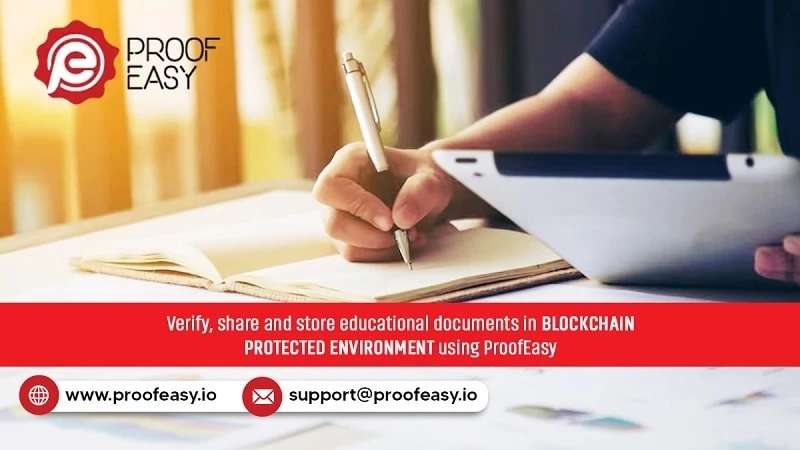Web 3.0, also known as the decentralized web, is the next evolution of the internet. It is an emerging technology that has the potential to revolutionize the education sector by creating a decentralized, open, and transparent system that can make education accessible, affordable, and personalized for learners of all ages and backgrounds.
The presence of Web 3.0 is already seen with the advent of blockchain technology and increasing companies showing interest in embracing it. ProofEasy is one such platform that uses Web 3.0 blockchain technology to create a secure interface where documents can be created, verified and shared.
In this article, we will explore the potential of Web3 technology to transform education and discuss some of the key benefits and challenges of implementing this technology in the education sector.
What Is Web 3.0?
Web 3.0 is a new internet protocol that uses blockchain technology to enable decentralized, peer-to-peer interactions between users. Unlike the current internet, which is centralized and controlled by a few dominant corporations, Web 3.0 is open, transparent, and owned by its users.
This means that anyone can create, share, and access content without the need for intermediaries, such as social media platforms, search engines, or online marketplaces. Web 3.0 technology is based on three main principles: decentralization, open protocols, and cryptography.
Decentralization means that there is no central authority that controls the network, and all users have equal rights and responsibilities. Open protocols mean that anyone can create and use the network without permission or approval, and the rules are transparent and publicly accessible. Cryptography means that all interactions on the network are secure and private, and users can control their own data and identity.
How Can Web 3.0 Revolutionize Education?
Web3 technology has the potential to revolutionize education in many ways. Here are some of the key benefits of using Web 3.0 in the education sector:
Decentralization: Web 3.0 technology can decentralize education by removing intermediaries, such as publishers, content providers, and certification authorities, and allowing learners and educators to interact directly with each other. This can reduce costs, increase transparency, and create a more equitable and democratic system.
Personalization: Web 3.0 technology can personalize education by creating customized learning paths based on the learner\'s interests, skills, and preferences. This can enhance the learning experience, increase motivation, and improve retention rates.
Ownership: Web 3.0 technology can give learners ownership of their data, credentials, and achievements by using blockchain technology to create tamper-proof records that are stored on a decentralized network. Blockchain document storage can increase the value of their learning, enhance their employability, and create a more trustworthy and reliable system.
Collaboration: Web 3.0 technology can enable learners and educators to collaborate and co-create content in a decentralized and peer-to-peer manner. Therefore, enabling to foster creativity, innovation, and community building, and create a more participatory and engaging learning environment.
Global access: Web 3.0 can provide global access to education by creating a decentralized and open system that can reach learners in remote and underserved areas. Resulting in increasing the accessibility of education, reducing the digital divide, and creating a more inclusive and diverse system.
Challenges of Implementing Web 3.0 in Education
While Web 3.0 technology has many potential benefits for education, there are also some challenges that need to be addressed before it can be widely adopted. Here are some of the key challenges of implementing Web 3.0 in education:
Technical complexity: Web 3.0 technology is still in its early stages of development, and it requires technical expertise to use and implement. Hence, this can be a barrier for educators and learners who may not have the necessary skills or resources to use Web 3.0.
Regulatory issues: Web 3.0 is not yet regulated, and there are legal and ethical issues that need to be addressed, such as privacy, security, intellectual property, and digital identity. These issues may vary from country to country, and they need to be resolved before Web 3.0 can be widely adopted in the education sector.
Infrastructure requirements: Web 3.0 technology requires a decentralized infrastructure, such as blockchain networks, decentralized storage, and peer-to-peer communication protocols. This infrastructure is still developing, and it may not be readily available or accessible to all learners and educators. It also requires significant computing power, energy consumption, and storage capacity, which may pose environmental and economic challenges.
Adoption and awareness: Web 3.0 is still relatively unknown and unfamiliar to many educators and learners. It requires a shift in mindset and culture, as well as new skills and practices, to fully leverage its potential. This requires awareness-raising, education, and training programs, as well as incentives and rewards for early adopters.
Interoperability: More importantly, Web 3.0 technology relies on open protocols and standards, but there is currently a lack of interoperability between different blockchain networks, decentralized applications, and Web3 platforms. This can create fragmentation, silos, and inefficiencies, and hinder the seamless integration and exchange of data, content, and services.
Conclusion
Web 3.0 technology has the potential to revolutionize the education sector by creating a decentralized, open, and transparent system that can make education more accessible, affordable, and personalized for learners of all ages and backgrounds. However, there are also significant challenges that need to be addressed before its widespread adoption.
These challenges require collaboration, innovation, and investment from all stakeholders, including educators, learners, policymakers, entrepreneurs, and technologists. By working together, we can unlock the full potential of Web 3.0 and create a more equitable, inclusive, and sustainable education system for the future.
Pioneering platforms such as ProofEasy are already making its use through Web 3.0 blockchain technology to create viable document solutions.



